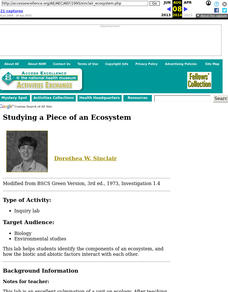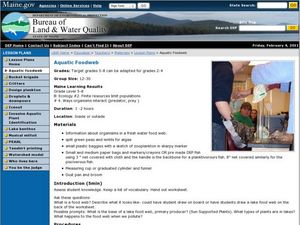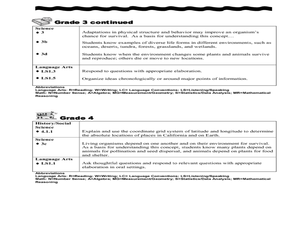Curated OER
Reduce, Reuse, Recycle
Fourth graders discover the differences between: reduce, reuse, and recycle by performing hands on examinations. They list what would happen to the soil if we allowed the earth to wash away and briefly discuss the meaning of erosion.
Curated OER
Changing Sounds
Students identify how the pitch and the loudness of an instrument can be altered. In this online science of sound lesson, students employ the use of an interactive whiteboard to examine the loudness and pitch of a guitar, drum, and...
Curated OER
Changing State
Students investigate the cooling and heating of water. In this online science experiment lesson, students work in groups to make predictions regarding freezing and boiling points and then test those predictions as they complete the...
Curated OER
How We See Things
Students explain that when a beam of light is reflected from its surface, it changes direction. In this virtual science experiment lesson plan, students complete an activity that requires them to investigate how flat mirrors reflect...
Curated OER
Characteristics of Materials
Students describe and compare common properties of various classroom materials. For this science/matter lesson, students observe common classroom items and the materials they are made of to complete a list of common properties.
Curated OER
Peanut Anatomy
Students explore the peanut plant. In this peanut lesson plan, students discuss the needs and parts of regular plants. They research peanut plants to see why they are unique.
Curated OER
Plant Cycles
Students identify plants parts and their functions. In this plant cycle instructional activity, students examine parts of plants and how the parts help them survive in its environment. Students use graphic organizers, the internet,...
Curated OER
Root, Root, Root for the Nutrients
Students observe the growth of a seed, predict what will happen when seeds are planted without soil, and conduct an experiment using a hydroponics system.
Curated OER
Aztec Floating Gardens
Aztecs created amazing hydroponic gardens called Chinampas, to grow their crops. Learners in grades k-7 engage in four mini-experiments to understand just how amazing floating gardens are. Tip: A perfect way to bring science into your...
Curated OER
Four Parts of a Green Plant and the Functions of Each Part
Learners look into plants. In this science lesson plan, students discover the four parts of a green plant and the functions of each part.
Curated OER
Natural Gardening
Students study the effect of pesticides on plants and insects. In this gardening instructional activity, students discuss the importance of insects. They define pesticides, evaluate their effectiveness and the problems they might...
Curated OER
Nuts About Peanuts
First graders explore peanuts. In this peanut lesson, 1st graders examine the parts of peanut plants and identify them. Students plant their own peanut plants and chart their growth.
Curated OER
Adventures With Super-Absorbers and Substance Solubility
Students understand the concepts of absorption, swellability and solubility and recognize that science is all around us in our everyday lives and is fun to explore.
Curated OER
What's Organic?
Learners define and discuss terms organic and synthetic, read article pertaining to organic agricultural practices in Oklahoma, complete worksheet, grow plants using both commercial and organic fertilizer, compare growth rates, and chart...
Curated OER
Flower Dissection
Students investigate th anatomy of a flower. They investigate the structures and processes by which flowering plants generate pollen, ovules, seeds, and fruit through dissection,
Curated OER
Studying a Piece of an Ecosystem
Learners carry out an outdoor land study in which they identify organisms living in the soil, and any other animals living within the site. Groups also examine abiotic factors. They respond to a series of questions concerning their data...
Curated OER
Marine & Aquatic Habitats Activities - Walk in the Wetlands
Students research various types of fresh water wetlands and identify the common animal and plant life in these different ecosystems. They further analyze the need to protect these wetlands and explore their varied uses.
Curated OER
Aquatic Foodweb
Learners explore what a food web is. In this science lesson, students examine how nutrients and other pollutants enter a lake and play a food web game whereby learners pretend they are either zooplankton, planktivore,...
Curated OER
Earth Pockets
Students identify the Earth's natural resources. In this Earth science lesson, students read the book The Great Kapok Tree and discuss types of natural resources. Students use categories such as wood, paper, and trees and list items that...
Curated OER
Planting Phil's Garden
Students study how to care for plants. In this plant care lesson, students observe a plant care demonstration and examine flowers using their senses. They listen to Janet Wakefield's, What If Everybody Gave? They complete a community...
Curated OER
Taking Care of Nature (Religious)
Young scholars discover how they can help care for the earth. In this environmental protection lesson, students discuss how God created the earth and what will happen if they fail to care for the earth properly. Young scholars grow...
Curated OER
Vertebrate History in Rocks
For this reading comprehension worksheet, students read the noted section in their science textbooks and respond to 4 short answer and 3 fill in the blank questions regarding fossils embedded in rock formations.
Curated OER
Vibrant Volcanoes
Students explore volcanoes. In this science lesson, students discuss the characteristics of volcanoes and view a video segment about a volcano. Students examine plate tectonics.
Curated OER
Fun with Flowers
Students make observations of flowers. In this life science lesson, students look at flowers, then draw and color their favorite flowers. Lesson includes extension activities.























